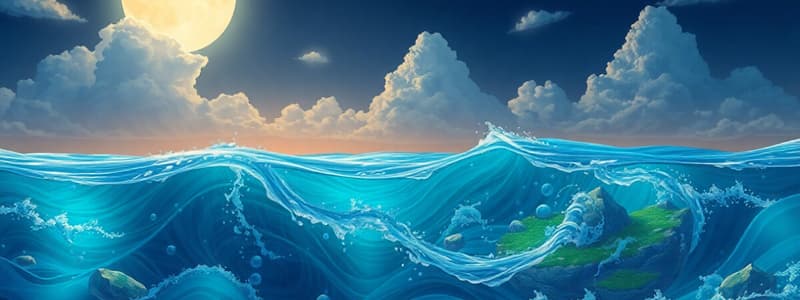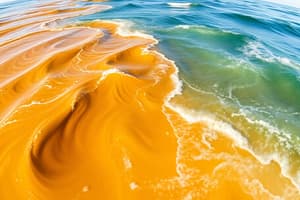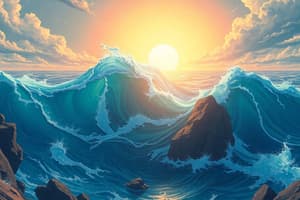Podcast
Questions and Answers
What phenomenon causes the rise and fall of sea levels known as tides?
What phenomenon causes the rise and fall of sea levels known as tides?
- Coriolis effect
- Tidal forces (correct)
- Wind-driven circulation
- Upwelling
Which layer of the ocean is primarily affected by wind stress?
Which layer of the ocean is primarily affected by wind stress?
- Surface layer
- Ekman layer (correct)
- Deep ocean layer
- Thermocline layer
How does the Coriolis effect influence the movement of water in the Northern Hemisphere?
How does the Coriolis effect influence the movement of water in the Northern Hemisphere?
- Water is deflected to the left
- There is no effect on water movement
- Water is deflected to the right (correct)
- Water moves straight with the wind
What is Ekman transport?
What is Ekman transport?
What is the relationship between wind speed and current speed?
What is the relationship between wind speed and current speed?
What are upwelling and downwelling associated with in oceanography?
What are upwelling and downwelling associated with in oceanography?
How does wind-driven circulation influence marine ecosystems?
How does wind-driven circulation influence marine ecosystems?
What is the characteristic of ocean currents at greater depths compared to the surface?
What is the characteristic of ocean currents at greater depths compared to the surface?
What process occurs when surface water moves away from the coast due to the Coriolis effect?
What process occurs when surface water moves away from the coast due to the Coriolis effect?
What is the primary role of upwelling in marine ecosystems?
What is the primary role of upwelling in marine ecosystems?
What initiates thermohaline circulation in the oceans?
What initiates thermohaline circulation in the oceans?
How does downwelling contribute to deep-sea ecosystems?
How does downwelling contribute to deep-sea ecosystems?
What is the main driver of wind-driven ocean circulation?
What is the main driver of wind-driven ocean circulation?
What primarily drives tide-driven circulation in the oceans?
What primarily drives tide-driven circulation in the oceans?
Which of the following best describes thermohaline circulation?
Which of the following best describes thermohaline circulation?
What happens to colder and saltier water in thermohaline circulation?
What happens to colder and saltier water in thermohaline circulation?
What is created on the side of the Earth facing the moon due to gravitational attraction?
What is created on the side of the Earth facing the moon due to gravitational attraction?
What role do oceans play in climate regulation?
What role do oceans play in climate regulation?
What effect do rising tides have on coastal and estuarine environments?
What effect do rising tides have on coastal and estuarine environments?
Which component of ocean dynamics refers to the movement of ocean water caused primarily by the gravitational forces from the moon and sun?
Which component of ocean dynamics refers to the movement of ocean water caused primarily by the gravitational forces from the moon and sun?
In ocean dynamics, what is meant by 'ocean mixing'?
In ocean dynamics, what is meant by 'ocean mixing'?
What is one of the critical roles of ocean dynamics in marine ecosystems?
What is one of the critical roles of ocean dynamics in marine ecosystems?
How do ocean dynamics influence weather phenomena such as hurricanes?
How do ocean dynamics influence weather phenomena such as hurricanes?
What effect does ocean stratification have on marine life?
What effect does ocean stratification have on marine life?
What phenomenon occurs in an area of low pressure that draws in surrounding winds?
What phenomenon occurs in an area of low pressure that draws in surrounding winds?
Which term refers to tropical cyclones occurring in the northwestern Pacific Ocean?
Which term refers to tropical cyclones occurring in the northwestern Pacific Ocean?
What is one major factor that affects the stability of marine structures?
What is one major factor that affects the stability of marine structures?
What role do ocean currents play in relation to marine structures?
What role do ocean currents play in relation to marine structures?
Which of the following processes is NOT critical for ensuring the longevity of marine structures?
Which of the following processes is NOT critical for ensuring the longevity of marine structures?
In which ocean do hurricanes specifically occur?
In which ocean do hurricanes specifically occur?
Why is understanding ocean dynamics important for engineers?
Why is understanding ocean dynamics important for engineers?
Which of the following is a crucial aspect of studying ocean dynamics?
Which of the following is a crucial aspect of studying ocean dynamics?
What is the primary feature of ebb currents?
What is the primary feature of ebb currents?
Which of the following correctly describes El Niño?
Which of the following correctly describes El Niño?
What drives the seasonal changes experienced during a monsoon?
What drives the seasonal changes experienced during a monsoon?
How do surface currents affect global climate?
How do surface currents affect global climate?
What is a defining characteristic of La Niña?
What is a defining characteristic of La Niña?
Which statement about hurricanes, cyclones, and typhoons is correct?
Which statement about hurricanes, cyclones, and typhoons is correct?
What effect does the wind have on ocean currents?
What effect does the wind have on ocean currents?
What is the meaning of the word 'monsoon' in Arabic?
What is the meaning of the word 'monsoon' in Arabic?
Flashcards are hidden until you start studying
Study Notes
Ocean Dynamics
- The study of ocean dynamics focuses on the motion of ocean water and the driving forces behind these movements.
- These forces include wind, temperature and salinity differences, the Earth's rotation and gravitational interactions with the moon and sun.
- Understanding ocean dynamics is critical for:
- Climate regulation
- Supporting marine ecosystems
- Weather prediction
- Human activities such as navigation, fishing, coastal management and environmental protection
- Safety of marine structures
Key Components
- Ocean Circulation: The large-scale movement of water within the world's oceans, driven by wind, temperature, salinity differences, and the Earth's rotation.
- Types: Wind-driven, Thermohaline, Tide-driven
- Waves: The periodic rise and fall of the ocean surface caused by disturbances such as wind, earthquakes, or landslides.
- Tides: The regular rise and fall of sea levels due to the gravitational influence of the moon and the sun.
- Upwelling and Downwelling: The vertical movement of water in the ocean.
- Upwelling: The rising of cooler, nutrient-rich water from the depths to the surface. Supported by wind blowing parallel to the coastline, and the Coriolis effect.
- Downwelling: The sinking of warmer, oxygen-rich surface water to the depths. Caused by wind blowing toward the coast.
- Ocean-Atmosphere Interactions: The dynamic exchange of energy, momentum, water, and gases between the ocean and the atmosphere.
- El Niño - Southern Oscillation (ENSO): A climatic phenomenon characterized by unusual variations in sea surface temperatures in the tropical Pacific Ocean.
- El Niño: Warmer than average sea surface temperatures, weakened trade winds, wetter conditions in America, drier conditions in Asia.
- La Niña: Cooler than average see surface temperatures, stronger than average trade winds, heavier rainfall in Asia, more frequent floods.
- Monsoon: A seasonal change in wind direction caused by the differential heating of land and sea.
- El Niño - Southern Oscillation (ENSO): A climatic phenomenon characterized by unusual variations in sea surface temperatures in the tropical Pacific Ocean.
- Heat and Salt Transport: The circulation of heat and salt within the ocean.
- Ocean Mixing and Stratification: The processes that cause the vertical distribution of water properties, such as temperature, salinity, and nutrients..
Wind-driven Circulation
- Driven by surface wind stress on the ocean.
- Key factors:
- The Coriolis effect: Earth's rotation causes deflection of moving fluids, responsible for the movement of large-scale ocean currents and atmospheric circulation.
- Ekman transport: The wind-driven water transport deflected by the Earth's rotation. This moves the surface water 90 degrees to the right of the wind in the northern hemisphere, and 90 degrees to the left of the wind in the southern hemisphere.
- Forms large-scale ocean currents, gyres, and contributes to upwelling and downwelling.
Thermohaline Circulation
- Also known as the global conveyor belt.
- Driven by density differences in seawater, influenced by temperature and salinity.
- Colder, saltier water sinks, while warmer, less salty water rises.
- Plays a crucial role in regulating the Earth's climate by redistributing heat.
Tide-driven Circulation
- Driven by gravitational forces exerted by the moon and the sun.
- Creates high tides on the side of the Earth facing the moon, and on the opposite side due to inertia.
- Responsible for the rise and fall of sea levels, which generate currents.
- Influences sediment transport, nutrient cycling, and marine ecosystems in coastal and estuarine environments.
Ocean Dynamics and marine structures
- Ocean dynamics significantly impact marine structures.
- Ocean currents exert forces on these structures, affecting their stability and integrity.
- Waves generate significant forces, causing short-term and long-term effects.
- Tidal movements cause fluctuations in water levels.
- Design engineers must account for ocean dynamics in the design and maintenance of these structures, by selecting appropriate materials, implementing dynamic response analysis, and continuous monitoring.
Conclusion
- Ocean dynamics encompasses a wide range of physical and chemical processes that govern the behavior and movement of ocean waters.
- Understanding these components is crucial for predicting weather patterns, managing marine resources, and studying climate change.
Studying That Suits You
Use AI to generate personalized quizzes and flashcards to suit your learning preferences.




